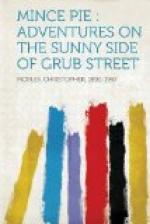Yesterday we went out to buy our annual corncob, and were agreeably surprised to learn that the price is still six cents; but our friend the tobacconist said that it may go up again soon. We took the treasure, gleaming yellow with fresh varnish, back to our kennel, and we are smoking it as we set down these words. A corncob is sadly hot and raw until it is well sooted, but the ultimate flavor is worth persecution.
The corncob pipes we always buy come from Boonville, Mo., and we don’t see why we shouldn’t blow a little whiff of affection and gratitude toward that excellent town. Moreover, Boonville celebrated its centennial recently: it was founded in 1818. If the map is to be believed, it is on the southern bank of the Missouri River, which is there spanned by a very fine bridge; it is reached by two railroads (Missouri Pacific and M., K. and T.) and stands on a bluff 100 feet above the water. According to the two works of reference nearest to our desk, its population is either 4252 or 4377. Perhaps the former census omits the 125 men of the town who are so benighted as to smoke briars or clays.
Delightful town of Boonville, seat of Cooper County, you are well named. How great a boon you have conferred upon a troubled world! Long after more ambitious towns have faded in the memory of man your quiet and soothing gift to humanity will make your name blessed. I like to imagine your shady streets, drowsing in the summer sun, and the rural philosophers sitting on the verandas of your hotels or on the benches of Harley Park ("comprising fifteen acres”—New International Encyclopedia), looking out across the brown river and puffing clouds of sweet gray reek. Down by the livery stable on Main street (there must be a livery stable on Main street) I can see the old creaky, cane-bottomed chairs (with seats punctured by too much philosophy) tilted against the sycamore trees, ready for the afternoon gossip and shag tobacco. I can imagine the small boys of Boonville fishing for catfish from the piers of the bridge or bathing down by the steamboat dock (if there is one), and yearning for the day when they, too, will be grown up and old enough to smoke corncobs.
[Illustration]
What is the subtle magic of a corncob pipe? It is never as sweet or as mellow as a well-seasoned briar, and yet it has a fascination all its own. It is equally dear to those who work hard and those who loaf with intensity. When you put your nose to the blackened mouth of the hot cob its odor is quite different from that fragrance of the crusted wooden bowl. There is a faint bitterness in it, a sour, plaintive aroma. It is a pipe that seems to call aloud for the accompaniment of beer and earnest argument on factional political matters. It is also the pipe for solitary vigils of hard and concentrated work. It is the pipe that a man keeps in the drawer of his desk for savage hours of extra toil after the stenographer has powdered her nose and gone home.




